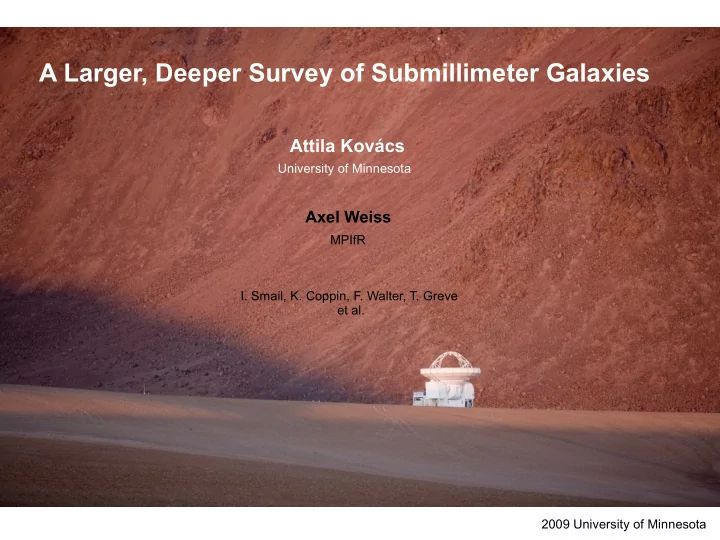

A Larger, Deeper Survey of Submillimeter Galaxies Attila Kovács University of Minnesota Axel Weiss MPIfR I. Smail, K. Coppin, F. Walter, T. Greve et al. 2009 University of Minnesota
Arp 220 The Energy Spectrum of a Luminous Galaxy Source: NED
Arp 220 The Energy Spectrum of a Luminous Galaxy 35 K (dust) Milky Way FIR fraction is about 50%, T~16K
Arp 220 at z=2.3 The Energy Spectrum of a Distant Luminous Galaxy? FIR is also good for studying distant populations?
The Cosmic Background Hasinger 2000 Infrared (and optical?) background may be due to such galaxies....
K-Correction Benefits... T. Greve 850 micron is equally sensitive to the same galaxy at z ~ 1-8...
Sky is Bright Analogy : Imaging a 17 mag star on a bright summer day Atmospheric Transmission at APEX
Bolometers A Galaxy far far away... (10 Gly, 35K) atmosphere (300K) Bolometers are just thermometers doing the impossible...
1998
Submillimeter Galaxies (SMGs) Hughes et al. 1998 The First Detections Hughes et al. 1998 Too many optical counterparts Or none at al... SCUBA
Hughes et al. 1998 1998 2003 2003
Redshift Distribution of SMGs Chapman et al 2003, 2005 Hopkins 2006 z ~ 2.3 Chapman et al. (2005) Optical redshifts At the radio ID position
z 0 0.5 1 2 3 1000 SMGs (z~1-3) 6 2
Hughes et al. 1998 1998 2003 2003 2006 Chapman et al. 2003 & 2005
Kovács et al. 2006 Temperatures & Luminosities Radio-FIR Correlation T ~ 35K, L ~ 10 13 L sun Luminosities fueled by star-formation
SHADES Coppin et al 2006 S CUBA Ha lf De gree S quared survey SCUBA 37 pixels Lockman Hole ( 485 arcmin 2 ) SXDF ( 406 arcmin 2 )
SHADES: Source Counts (brightness distribution) Formation Stellar Analogy: Evolution IMF (z-Distribution) Coppin et al. 2006
SHADES Hughes et al. 1998 Coppin et al. 2006 1998 2003 2003 2006 2007 Chapman et al. 2003 & 2005 Kovács et al. 2006
LABOCA (Large Bolometer Camera) Siringo et al. 2009 295 pixels
The Extended Chandra Deep Field South (CDFS) X-ray Chandra , XMM UV GALEX Opt HST GEMS/GOODS, COMBO-17 IR Spitzer IRAC/MIPS VLA 1.4GHz Radio 30' CHANDRA Optical
The CDFS at 870 microns 300 hours 19” beam (27” smoothed) 1.2 mJy/beam 125 sources (5 false) mJy/beam
The CDFS at 870 microns 300 hours 19” beam 1.2 mJy/beam 125 sources (5 false) mJy/beam
30'
Confusion Noise σ 2 obs = σ 2 m + σ 2 c Rule of Thumb When the number of sources per σ c ~ 0.7 mJy/beam beam exceeds 1, sources start to look like a noisy background.... Observed noise is the combination of measurement noise and confusion noise
How to Get Source Counts... The “Direct” Method... SHADES Recipe 1. Bin your sources 2. Assume dN/dS 3. Deboost with 4. get dN/dS
P ( D ) Analysis Many faint sources Bright sources Widen distribution Produce tail (confusion) P ( D ) analysis Observed distribution is a product of the source distribution and the underlying noise...
Schechter Barger
P ( D ) Results Power Law S min = 0.5 mJy N 0 = 92.7 mJy -1 deg -2 p = 3.178
Source Counts from the CDFS CDFS SHADES Integrated 870um Background: 29-33 Jy/deg 2 COBE: 45 +- 5
The Perfect View Over 12,000 sources mJy/beam
Cosmic Variance? Underdensities In the CDFS : Z > 2 K-band selected galaxies are under-abundant by ~60%. (Dokkum et al. 2006) Z > 2.5 DRGs (Marchesini et al. 2006) High-z optically bright AGNs (Dwelly & Page 2006)
Spatial Source (Flux) Distribution mJy/beam
Bright Source Flux Distribution Smoothed to 5' resolution
Cosmic Variance? Sparse Dense 30-38 Jy/deg 2 22-28 Jy/deg 2
Cosmic Variance? Seems more a variation in steepness rather than density
The Perfect View (assumed) Clustering of SMGs consistent with other high-z populations Corresponds to present epoch galaxy clusters Associated with more massive DM halos
Other high- z Populations Greve et al. 2009
Summary (so far...) Largest, deepest, cleanest to date 125 Galaxies A Better way of Analyzing Data Robust Source Counts Cosmic Variance?
Need Redshifts... SPECTROSCOPIC PHOTOMETRIC e.g. from Spitzer IRAC/MIPS Based on radio Positions From VLA 1.4 GHz Problem: Problem: Ambiguous MIR Ids Deep radio surveys have Within search radius Known redshift cutoff at z~3 NEED BETTER POSITIONS NEED BETTER POSITIONS For securing ID For optical followup
Troublesome IDs ACS 3.6um 24um VLA Pope et al. 2006
My Big Question... (What about the other half of SMGs?) FIR emission is More SMGs at not fueled by z>3 star-formation... than we think AGNs?
Looking for New Ways... Combined MIR/NIR analysis for isolating potential candidates (Wilson et al. 2004) E-VLA followup positions from thermal continuum, possibly redshift from CO(1-0) Wide band submm grating spectrometers For CO or CI transitions (e.g. z-SPEC) Herschel (esp. 200um) ALMA...
Interested?
Completeness Astrometry
LABOCA Beam Shape
BzK Selection
Measured a Flux S obs with some uncertainty What was the underlying flux producing the signal?
Measured a Flux S obs with some uncertainty What was the underlying flux producing the signal? A B Meaning : Probability of measuring value of S obs , if the true value is S
Deboosting When the underlying flux distribution p(S) is skewed.... E ( S ) = S obs
A More pathological Case of deboosting... p ( S ) ~ S -p
Recommend
More recommend